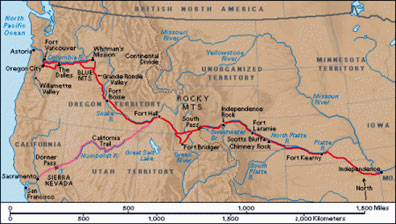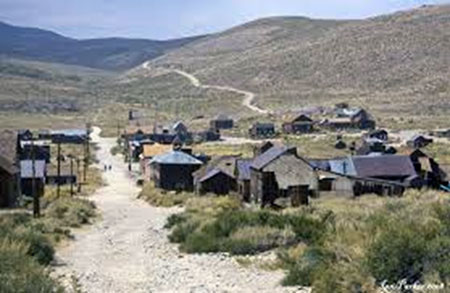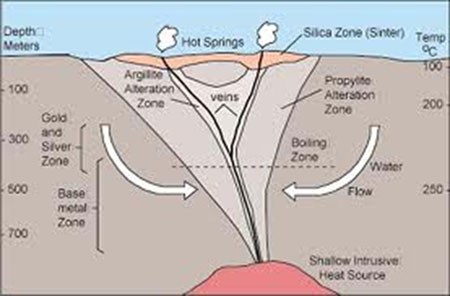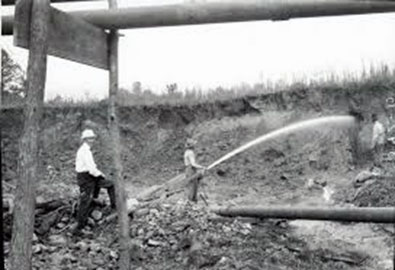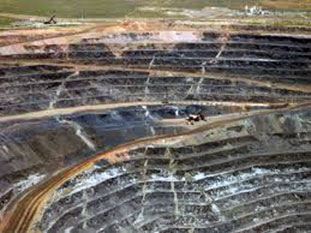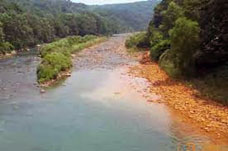Geology and Natural Heritage of the Long Valley Caldera
Gold in the West
Amelia Nelson
Abstract
This paper analyzes the effect of gold on the human society, economy and environment. By analyzing the effects of the discovery of gold in the west, one can see that it rapidly affected the movement of a young America and, in the long term, affected the environment that we know today.
Introduction
To many, gold is simply a beautiful piece of jewelry that signifies wealth and prosperity. Little do many know that gold has affected human society for thousands of years, shaping economies, political power and environments as it becomes discovered and produced in new areas. Gold began as a symbol of wealth in ancient civilizations, became a reason for hope for many Americans in the 19th century and is now a part of our society.
Global History of Gold
Gold has been in use by humans for at least 5,000 years in many different ways: jewelry, decoration, currency, electrical applications, dentistry, and in chemical and medical fields. The tomb of Tutankhamun, an Egyptian pharaoh who ruled in 14th century B.C., was found to be full of gold decorations. Near Nauplion, Greece, graves at the Citadel of Mycenae also included a large number of gold masks, cups, jewelry, beads and figurines. These works were created nearly 3,500 years ago. The Aztecs and Incas were also found to have gold treasuries; much of these gold artifacts were raided by the Conquistadores and melted and cast into coins and bars [Kirkemo et al., 1997]. In ancient times, gold’s association with immortality, wealth and the gods was common to many cultures globally, making it a widely sought-after item.
Eureka! The Gold Rush
Though gold was produced in both the Appalachian region and southern California in the late 18th century, it was not until 1848 that the famous western Gold Rush began. It was James Wilson Marshall who found gold in the water channel below Sutter’s Mill in Coloma, California on January 24, 1848 [Cutter, 2005]. Though this was not the first find of gold in California’s history, this was the find that sparked what is so widely discussed today, the California Gold Rush. By mid-March of 1848, the news had spread to a San Francisco newspaper. The headline read, "GOLD MINE FOUND". Through the spring and summer of 1848, the number of miners increased from a few hundred to more than four thousand. The news quickly spread east and by 1849 many were making the trek from east to west to seek riches; these people became known as the "forty niners." Different trails taken by land can be seen in figure 1:
Figure 1: image from http://www.worldbook.com
Though many traveled by land, many went by sea or traveled by both. Both modes of travel were dangerous and led to fatalities. By 1850, more than 300,000 gold seekers had flooded California [Sherrow, 1998].
Civilization in the West
As the west became populated with these forty-niners, mining camps and towns began to pop up. These communities ranged from being simple transient camps to being actual towns with shops, saloons and built houses. Life in both the mining camps and the "boomtowns" was dangerous. One such example is Bodie, a mining town in California. At its peak, Bodie had nearly 10,000 citizens living in the small hills near the mine [Bodie SHP]. The town, as it appears now, can be seen in figure 2:
Figure 2: image from parkerlab.bio.uci.edu
At first the town was largely neglected due to other gold finds in the area, but in 1876 a mine cave-in exposed a large body of gold. Following this find, the Standard Consolidated Mining Company invested in equipment and lumber to mine the area. This jumpstarted the town’s growth, leading to a bustling town full of saloons, brothels, gambling halls and opium dens. The mixture of greed, money, alcohol and drugs was dangerous for the citizens and led to daily violence. In 1881, Reverend F.M. Warrington explained the town as "a sea of sin, lashed by the tempests of lust and passion"[DesertUSA]. Bodie is a good example for how many of the boomtowns were during this period.
the mining of gold
the cause of gold deposits
Ore deposits are concentrations of metals in the ground that are rich enough to mine and refine. The ore deposits found in California were predominantly formed by hydrothermal waters that circulated close to the surface and carried with them dissolved minerals. These hydrothermal waters are a combination of both ground water and water from the magma and are a result of circulating groundwater that comes into contact with a magma intrusion and causes a reaction. This reaction causes some ore constituents to come out of the intrusion and be carried off by the water. These hydrothermal solutions then flow through fractures in the bedrock and slowly cool as they become closer to the surface. As they cool, some of the ore constituents dissolve out and are then deposited in the fractures. These deposits of ore are known as veins. The ore can either be deposited in the veins or distributed in the rock near the veins. This process can be seen in figure 3.
As the ore precipitates out, it commonly is precipitated with other vein-filling minerals, the most common being quartz and calcite [Marshak and Prothero, 2001]. This process is what creates a lode deposit, a deposit of gold in which the gold is still in the rock in which it was deposited. Contrastingly, a placer deposit is a concentration of natural material that has built up in sediments on a streambed, residual deposit or beach. These are usually a result of the erosion of lode deposits [Kirkemo, 2013].
Figure 3: image from volcano.oregonstate.edu
Mining Methods
The simplest way to extract gold from a placer deposit is by panning. Some mined ore is placed in a pan, combined with water and agitated so that the more dense gold particles will sink to the bottom of the pan. Though this is the simplest method, it is also the most time consuming and strenuous. This method was usually used to locate a placer deposit. Because panning was so difficult, this method was quickly replaced by cradles, long-toms and rockers. Cradles and rockers are boxes set on rockers that can hold more than a pan and requires less work. A long-tom has a greater capacity than all three of these and does not require the labor of rocking or panning but it does require a supply of running water. Hydraulic mining was also utilized; a high-pressure hose was used to spray a violent stream of water at the cliffs that contained the gravels and gold. This loosened sediment would be washed over riffles to separate the gold. Hydraulic mining was successful but devastating to the local environment. This process of hydraulic mining can be seen in figure 4:
Figure 4: image from goldrushgallery.com
While placer deposits supplied a good amount of gold, the miners realized that this gold must have an origin somewhere in the bedrock. They discovered quickly that the gold was associated with quartz veins and the mining of this rock began. The first attempts at this kind of mining were in 1849 in Mariposa and they persisted for nearly a century, until 1942 when a presidential order shut most of them down. At the beginning of this type of mining, there were many difficulties: the quartz was extremely hard and difficult to tunnel through and the process was very labor-intensive. This did not change until steam powered drills and dynamite were introduced in the 1860s and sped up the process. Once the quartz ore was brought to the surface it was processed in a stamp mill. In these mills, the ore was crushed into a fine powder so that the ore could be chemically treated and the gold would separate out. Mercury was most commonly used to treat the ore; the mercury will form an alloy with gold, this alloy is separated from the rest of the rock, then it is heated to evaporate the mercury [Hayes]. Bodie was one of the many mining towns that mined the quartz ore out of the bedrock.
Mining today
Though the Gold Rush was nearly 150 years ago, panning for gold seems to be slowly coming back. Due to a high price of gold, the poor economy and a large unemployment rate, panners are repopulating California streambeds. With the price of gold being currently over $1,000 an ounce, the idea of finding gold is becoming more appealing to the unemployed. The number of mining claims in California has even risen dramatically; at the end of March 2009 there were 24,583 active gold-mining claims in the state. Just in the first three months of 2009, 3,000 new mining claims were filed [Welch 2009]. Due to the high price of gold, gold mining is still a large industry in much of the world. Barrick Gold Corporation, one of the largest gold mining companies in the world, has mines concentrated in North America, South America and the Australian Pacific [CNNMoney]. The Barrick mining corporation usually uses either open-pit mining techniques or hardrock mining techniques. One of their open-pit mines can be seen in figure 5:
Figure 5: image from newsroom.unr.edu
Because much of the gold occurrences in the bedrock are finely disseminated, the ore must be extensively processed so the gold can be pulled out.
Environmental Concerns
Throughout its history, gold mining and mining in general has been a hazard to the environment and ecosystem in its path. The Gold Rush era alone was enough to damage and negatively affect the Sierra Nevada area in California. Hydraulic mining, which began in roughly 1853, introduced mercury to many of the water systems due to use of mercury-laden sluice boxes. This type of mining also moved a massive amount of sediment, changing the nature of streams, rivers and lakes of the Sierra. This continued until Congress passed the Caminetti Act of 1893 which allowed hydraulic mining to occur as long as downstream movement of sediment was controlled by debris dams [The Sierra Fund 2008].
Hard rock mining was also hazardous to the environment. The big fear is of acid-mine drainage. When buried rock is dug up, air and moisture can jumpstart chemical reactions that release acids and toxic metals such as sulfuric acid, arsenic and copper. These products can get into the groundwater and leach into nearby streams and lakes, altering the pH and affecting the ecosystem [Rastogi 2010]. Figure 6 shows an example of a creek in Pennsylvania affected by acid-mine drainage:
Figure 6: image from jan.ucc.nau.edu
The next step of extracting the gold from the ore poses even more risks. Mercury, because it forms a mixture with gold and then can be burned off to leave the gold behind, is the main substance used to extract gold. In placer and hydraulic mining, the mercury is added to sluice boxes; mercury is added to crushed ore in hard rock mining. Much of the excess mercury is washed into waterways with excess sediment. In lakes, rivers and streams, mercury can be converted by microbes into methylmercury which, when ingested, can get into the food chain. Due to biomagnification, the levels of mercury in larger fish can surpass levels of concern for both wildlife and human consumption.
One of the largest concerns regarding tailing has to do with the excess rock and sediment left behind once the job is done. Both hydraulic and hardrock mining leave behind large amounts of sediment and gravel known as tailings. For over 100 years, it was typical to utilize these tailings in the construction of infrastructure and buildings. This distributed toxic materials contained in the tailings such as asbestos, mercury and arsenic. The Surface Mining Control and Reclamation Act was passed in 1977, requiring that mines must be restored to their original condition once the mining job is complete. This act also required that before a permit to mine can be granted, a plan must be submitted on how the land will be restored and how any acid-mine drainage problems will be mitigated [Environmental Literacy Council]. Though the government is regulating mining companies, the environment is still becoming damaged so the society can have gold.
Conclusion
Throughout human society, gold has affected the economy and the environment around us. Though to many it is simply a piece of jewelry, it has shaped human society as it is found in new places. As the mining methods have grown from simple panning to large open-pit mines, the cost has becoming higher on the environments and ecosystems within range. Gold will continue to affect the earth and society around us.
works cited
"Bodie State Historic Park, CA." - DesertUSA. N.p., n.d. Web. 5 June 2014.
"Bodie SHP." Bodie SHP. N.p., n.d. Web. 13 June 2014.
Cutter, Donald C. "California Geological Survey - Gold Discovery." California Geological Survey - Gold Discovery. Department of Conservation, n.d. Web. 04 June 2014.
"Digging for Gold 2 Miles Deep." CNNMoney. Cable News Network, n.d. Web. 13 June 2014.
"Gold Mining." The Environmental Literacy Council. N.p., n.d. Web. 15 June 2014.
Hayes, Gary. "Mining History and Geology of the California Gold Rush." Modesto Junior College, n.d. Web. 6 June 2014.
Kirkemo, Harold. "Prospecting for Gold in the United States." Prospecting for Gold in the United States. USGS, n.d. Web. 5 June 2014.
Kirkemo, Harold, William L. Newman, and Roger P. Ashley. "Gold." The Analysts Journal 7.4 (1951): 17-19. US Geological Survey. Web.
Marshak, Stephen, and Donald R. Prothero. Earth: Portrait of a Planet. New York: Norton, 2001. Print.
Martinez, Lionel. Gold Rushes of North America: An Illustrated History. Secaucus, NJ: Wellfleet, 1990. Print.
Monohan, Carrie. "Mining’s Toxic Legacy." An Initiative to Address Mining Toxins in the Sierra Nevada (n.d.): n. pag. Sierra Fund, Mar. 2008. Web. 5 June 2014.
Rastogi, Nina S. "Production of Gold Has Many Negative Environmental Effects." Washington Post. The Washington Post, 21 Sept. 2010. Web. 05 June 2014.
Sherrow, Victoria. Life during the Gold Rush. San Diego, CA: Lucent, 1998. Print.
Welch, William M. "New Gold Rush Hits California." USA Today. N.p., 3 Apr. 2009. Web. 12 June 2014. website
[Return to Research Projects] [Return to Sierra Home]
